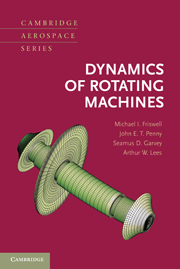Book contents
- Frontmatter
- Contents
- Preface
- Acronyms
- 1 Introduction
- 2 Introduction to Vibration Analysis
- 3 Free Lateral Response of Simple Rotor Models
- 4 Finite Element Modeling
- 5 Free Lateral Response of Complex Systems
- 6 Forced Lateral Response and Critical Speeds
- 7 Asymmetric Rotors and Other Sources of Instability
- 8 Balancing
- 9 Axial and Torsional Vibration
- 10 More Complex Rotordynamic Models
- Solutions to Problems
- Appendix 1 Properties of Solids
- Appendix 2 Stiffness and Mass Coefficients for Certain Beam Systems
- Appendix 3 Torsional Constants for Shaft Sections
- Bibliography
- Index
Preface
Published online by Cambridge University Press: 05 February 2015
- Frontmatter
- Contents
- Preface
- Acronyms
- 1 Introduction
- 2 Introduction to Vibration Analysis
- 3 Free Lateral Response of Simple Rotor Models
- 4 Finite Element Modeling
- 5 Free Lateral Response of Complex Systems
- 6 Forced Lateral Response and Critical Speeds
- 7 Asymmetric Rotors and Other Sources of Instability
- 8 Balancing
- 9 Axial and Torsional Vibration
- 10 More Complex Rotordynamic Models
- Solutions to Problems
- Appendix 1 Properties of Solids
- Appendix 2 Stiffness and Mass Coefficients for Certain Beam Systems
- Appendix 3 Torsional Constants for Shaft Sections
- Bibliography
- Index
Summary
This book addresses the dynamics of rotating machines, and its purpose may be considered threefold: (1) to inform readers of the various dynamic phenomena that may occur during the operation of machines; (2) to provide an intuitive understanding of these phenomena at the most basic level using the simplest possible mathematical models; and (3) to elucidate how detailed modeling may be achieved. This is an engineering textbook written for engineers and students studying engineering at undergraduate and postgraduate levels. Its aim is to allow readers to learn and gain a comprehensive understanding of the dynamics of rotating machines by reading, problem solving, and experimenting with rotor models in software.
The book deliberately eschews any detailed historical accounts of the development of thinking within the dynamic analysis of rotating machines, focusing exclusively on modern matrix-based methods of numerical modeling and analysis. The structure of the book (described in Chapter 1) is driven largely by the desire to introduce the subject in terms of matrix formulations, beginning with the exposition of the necessary matrix algebra. All of the authors are avid devotees of matrix-based approaches to dynamics problems and all are constantly inspired by the intricacy and detail that emerge from even relatively simple numerical models. The emergence of software packages such as MATLAB that enable what would once have been considered large matrix computations to be conducted easily on a personal computer is one of the most exciting and important innovations in dynamics in the past two decades. With such a package, sophisticated models of machines can be assembled “from scratch” using only a few prewritten functions, which are available from the Web site associated with this book.
- Type
- Chapter
- Information
- Dynamics of Rotating Machines , pp. xiii - xivPublisher: Cambridge University PressPrint publication year: 2010



